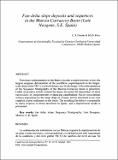Por favor, use este identificador para citar o enlazar a este item:
http://hdl.handle.net/10261/5749COMPARTIR / EXPORTAR:
 SHARE
BASE SHARE
BASE
|
|
| Visualizar otros formatos: MARC | Dublin Core | RDF | ORE | MODS | METS | DIDL | DATACITE | |

| Campo DC | Valor | Lengua/Idioma |
|---|---|---|
| dc.contributor.author | Dabrio, Cristino J. | - |
| dc.contributor.author | Polo, M. D. | - |
| dc.date.accessioned | 2008-07-10T12:34:02Z | - |
| dc.date.available | 2008-07-10T12:34:02Z | - |
| dc.date.issued | 1991 | - |
| dc.identifier.citation | Cuadernos de Geología Ibérica, N.º 15, 49-71. Madrid, 1991. | en_US |
| dc.identifier.issn | 0378-102X | - |
| dc.identifier.uri | http://hdl.handle.net/10261/5749 | - |
| dc.description.abstract | [EN] Tortonian sedimentation in the Betics records a major tectonic event, the largest orogenic deformation of the cordillera, suporimposed on the largerscale, third-order TB 3.2 cycle ofeustatic sea-level change. A first interpretation of the Sequence Stratigraphy of the Murcia-Carrascoy basin is presented. Uplift of positive reliefs around the basin favoured the deposition of thick successions of conglomorates evidencing cannibalism. Facies associations witness deposition on the steep siope of a basin, fed by mountain rivers that supplied coarse sediments to the basin. The resulting fan delta is comparable in many respects to those described in fjords, and a depositional model is presented. | en_US |
| dc.description.abstract | [ES] La sedimentación tortonienso en las Béticas registra la superposición de un gran evento tectónico, correspondiente a la deformación más importante de la cordillera, y del ciclo global TB 3.2 de cambios del nivel de mar. Se ofrece la primera propuesta de interpretación de la cuenca de Murcia-Carrascoy en términos de Estratigrafía Secuencial. La surrección de relieves positivos alrededor do la cuenca favoreció el depósito de potentes acumulaciones de conglomerados que manifiestan la autofagia de la cuenca. Las asociaciones de facies indican que el depósito se produjo en un talud de cuenca abrupta alimentado por ríos de montaña que aportaba materiales de grano grueso. El fan delta resultante es comparable en muchos aspectos a los descritos en fiordos y se presenta un modelo sedimentario. | en_US |
| dc.description.sponsorship | Finasacia] support from Programación Científica del CSIC 630/070. | en_US |
| dc.format.extent | 3641114 bytes | - |
| dc.format.mimetype | application/pdf | - |
| dc.language.iso | eng | en_US |
| dc.publisher | Universidad Complutense de Madrid | en_US |
| dc.rights | openAccess | en_US |
| dc.subject | Fan delta | en_US |
| dc.subject | Slope | en_US |
| dc.subject | Sequence Stratigraphy | en_US |
| dc.subject | Late Neogene | en_US |
| dc.subject | Murcia, S. E. Spain | en_US |
| dc.subject | Talud | en_US |
| dc.subject | Estratigrafía | en_US |
| dc.subject | Secuencial | en_US |
| dc.subject | Neógeno Superior | en_US |
| dc.title | Fan-delta slope deposits and sequences in the Murcia-Carrasco y Basin (Late Neogene, SE. Spain) | en_US |
| dc.type | artículo | en_US |
| dc.description.peerreviewed | Peer reviewed | en_US |
| dc.type.coar | http://purl.org/coar/resource_type/c_6501 | es_ES |
| item.openairetype | artículo | - |
| item.languageiso639-1 | en | - |
| item.fulltext | With Fulltext | - |
| item.grantfulltext | open | - |
| item.cerifentitytype | Publications | - |
| item.openairecristype | http://purl.org/coar/resource_type/c_18cf | - |
| Aparece en las colecciones: | (IGE) Artículos | |
Ficheros en este ítem:
| Fichero | Descripción | Tamaño | Formato | |
|---|---|---|---|---|
| JIGE9191110049A.pdf | 3,56 MB | Adobe PDF |  Visualizar/Abrir |
CORE Recommender
Page view(s)
333
checked on 05-may-2024
Download(s)
152
checked on 05-may-2024
Google ScholarTM
Check
NOTA: Los ítems de Digital.CSIC están protegidos por copyright, con todos los derechos reservados, a menos que se indique lo contrario.
